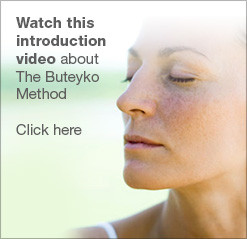South China Morning Post. Features. Monday, February 19, 2001
BUTEYKO BREATHING
Dr Rose Ong
As a first-time mother, one of the hardest things I’ve ever had to do was to watch my toddler gasping for breath during an acute asthmatic attack. With the worsening air pollution problem in Hong Kong, it was enough to send me running to the drug store to stock up on bronchodilator and steroid inhalers. These medicines became my security blanket. Like most parents, the thought of keeping my child on chronic medications was disturbing, but there didn’t seem to be any alternatives . . . or were there?
Buteyko Breathing Technique, or BBT, was invented by a Russian scientist, Dr Konstantin Buteyko. After World War II, he decided to dedicate himself to the study of the ‘most complicated piece of machinery of all, the human organism’. In 1946, he enrolled in the First Medical Institute in Moscow and worked with patients suffering from a variety of medical problems, including many with breathing difficulties. He observed that patients suffering from high blood pressure, hay fever, sinusitis, asthma, chest pains, and emphysema all breathed abnormally. While the average breathing volumes of a normal adult is around 5 litres per minute, they were breathing up to three times that much.
Buteyko concluded there was a connection between dysfunctional breathing and more than 200 disease states. He theorised the problem wasn’t due to insufficient oxygen, since these patients generally breathed too much rather than too little. He felt the key was carbon dioxide.
He thought with dysfunctional hyperventilation, as the condition was known, the amount of carbon dioxide dropped too low, leading to bronchospasms – contractions of the small airways.
In 1952, he devised a drug-free programme that taught patients to recondition their breathing pattern. When the breathing is normalised, carbon dioxide levels increase, leading to the opening of small airways and improvements of many chronic diseases. Carbon dioxide has long been recognised as playing an important role in the brain’s respiratory control centre, mediating metabolic pathways, enzyme reactions and the immune system. Buteyko experimented on himself and cured himself of the high blood pressure and headaches he had been suffering.
In 1990, BBT was introduced to Australia. Since then, Buteyko practitioners have treated more than 10,000 patients with favourable results. In 1994, BBT was introduced to Britain.
Any ideas, though, that a non-surgical, non-medical alternative to treating asthma – an increasing epidemic worldwide for reasons unknown – would be welcomed by health professionals, would be mistaken.
Instead, Buteyko practitioners are unhappy over the lack of acceptance by mainstream medical practitioners, despite more than 40 years of clinical trials and positive experiences with thousands of patients.
A well-controlled clinical trial was conducted in Australia in 1995, comparing a group of chronic asthma patients dependent on bronchodilator and steroid medications, to a matched control group. For three months the BBT group experienced a 90 per cent decrease in the use of bronchodilator medications compared to the control group. They also reported improvement in their quality of life. With longer term follow-up, the BBT group was found to require lower levels of steroids. All the positive findings would normally have been convincing enough to sway even the most sceptical scientist. However, two key observations were made which were troubling. One was that the clinical improvements did not correlate with increasing carbon dioxide levels in test subjects, as would have been hoped if the underlying principle proposed by Buteyko were correct (although this could have been the result of the testing procedures). The second was that when the BBT subjects’ lung functions were measured objectively using peak flow meters, there was no significant improvement, even if the patients felt better! Instead of clearing the air, the study merely created more confusion and controversy. Clearly more studies are needed. It may take a leap of faith, but if there is a way my child can be cured of asthma without the use of medications, sign me up.
Visit Web site www.buteykoasia.com for more information.
